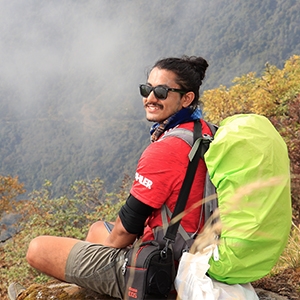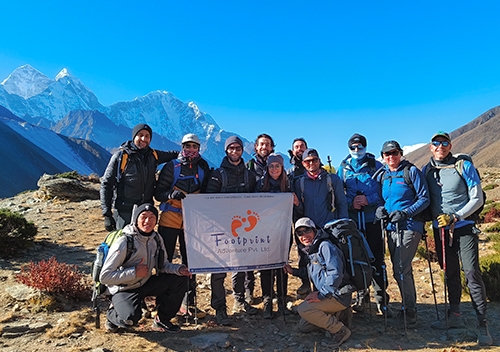Spring (March-May)
The spring months are probably the most popular in the region as a whole. You might be caught in the occasional snow showers in early February-late winter, but the weather should be largely stable and dry which is perfect for trekking and high altitude climbing. The Spring season provides a clear and undisturbed panoramic view of the beautiful mountains. Filled with red blooming rhododendrons amidst the dense green forest, the trail takes you along gushing rivers.

The ideal weather comes at a price as the routes during this time will be at their busiest. Most Everest summits occur during these months so you will likely come across many climbers, summiteers, and their support crews. The region is also the most vibrant at this time of the year, with many of the routes flanked by flowering rhododendrons, clear blue sky, warm sun, the colorful prayer flags moving from the breeze.
Autumn (Sept-Oct)
Another best time of the year to trek to the Everest base camp is the autumn or post-monsoon season. Generally, the autumn season starts from September to October. It is the main season where the Everest region sees a surge of trekkers and visitors trekking to the Everest base camp. Mid-September to November is one of the best times for Everest Base Camp Trek.
Clear days are characteristic of this popular trekking period. Although colder days (and colder nights) are to be expected, this is a small price to pay for the wonderful vistas and perfect views of the region's peaks. A bonus of trekking during this time is the option to choose some other, less well-known routes in the area that still offer amazing views but without the hustle and bustle of the more popular routes. The Gokyo Lakes Trek to the Everest Base Camp is a perfect example. This season is trendy among the trekkers also because it provides splendid panoramic views with less heat haze and clouds.

As the rainy season comes to a halt, the lush landscapes blossom with bright flowers while the river gushes out strongly and the crisp weather offers you a mesmerizing view of the Himalayas. With warm, pleasant days and chilly nights, the temperature during this season is around 15 degrees Celsius. Blessed with the unhampered views of the jewel of Nepal, Mt. Everest, you will surely get the best of the Everest region during autumn.
Monsoon (June-Aug)
The monsoon season (June to early September) is not ideal for traveling to Everest Base Camp. Aside from the wet weather which can lead to landslides on trails and muddy conditions, rainclouds can obscure the mountain views. But, temperatures are also warmer at this time, and it rains all day every day. If you're well prepared for the rain and don't mind getting a bit wet along the way though, trekking in the monsoon can be fine because the higher you go in altitude, the less rain there tends to be.
The trail conditions are not the safest, the trek will be wet and unenjoyable and you won’t even be able to get any great pictures of the beautiful mountain peaks. Even if trekking isn't on your agenda but a helicopter tour to Everest Base Camp is, these are also best when the weather is clear and predictable. It is best to avoid monsoon months for trekking to Everest Base Camp.

The weather won't only affect your experience in the Everest region, it also has the potential to affect flights from Kathmandu to Lukla. The most popular option for the Everest Base Camp Trek is a scenic flight to Lukla from Kathmandu and start the trek from there, but flights are frequently canceled when the weather and visibility are poor in Kathmandu, Lukla, or en route. Flights outside of the monsoon season are more likely to run as scheduled, but rain, fog, or smog can affect flights at any time of year.
Winter (Nov-Jan)
The winter (November, December, and January) isn't necessarily a bad time to trek to EBC, but it's certainly the off-season. Temperatures can get extremely cold, so you'd need to be well prepared for freezing conditions. This season sees a lot of snow, and the high passes remain closed. But, the skies tend to be very clear in winter, meaning excellent mountain views. And, you won't be hustling for space with other trekkers en route. As it is off-season routes would be empty and also tour prices and flight costs tend to drop a little bit now too. However, if you want to avoid the crowd and enjoy an isolated trekking experience, winter trekking to the Everest Base Camp is the perfect choice for you.
Peek Season Crowds
Spring and autumn are the peak seasons in Nepal, and as the Everest Base Camp Trek is Nepal's most popular, trails can get crowded at these times. There's no chance you'll have the main trails to yourself, and you may also struggle to get your first pick of accommodation. Trekking with a guide is always a good idea, but even more so in the peak season as they will be able to secure beds for you that might be difficult if you were traveling independently. Additionally, the Everest climbing season runs from May to early June, so even if you have no intention of climbing the mountain yourself, the area will be busy with expeditions in these months.
Flights to Lukla also sell out quite far in advance during peak season, so book these as early as possible. In the winter and monsoon, you won't encounter the same crowds. But while you may not struggle to get a bed in a good teahouse as you might in peak season, a lot of places close in the off-seasons.
Conclusion
Everest base camp trek is one of the best trekking destinations in the world. If you do not have Everest Base Camp on your bucket list, you are seriously missing out on the best trekking experience. You can trek to Everest base camp any time of the year, but there are some best seasons when you can experience the best of the Everest region. So, if you are planning to visit the Everest base camp, you should check out the best time for your journey. Contact us for the more information regarding the trekking and tour in Nepal.
FAQs
How cold does it get at Everest Base Camp?
At the Everest Base Camp of 5,364m, the temperature can go down to – 15°C to – 20°C during spring and autumn months when most trekkers take the trek. Winter is particularly very cold and at times it drops as low as -30 0C (-22 0F) or lower. It may still be cool in the day time though warmer than the early morning especially in areas with higher altitudes.
Which month is best for the Everest Base Camp trek?
It is suggested that the best time for trekking the EBC is during the April and October. These months present good climate, less fogginess and best season for trekking because of favorable temperate during the day and clear weather to see mountains in a clear looks.
Everest Base Camp trek is quite challenging but those in good physical condition won’t find it very tough.
How difficult is the Everest Base Camp trek?
The trek to the base camp of Mt. Everest is classified as moderate trek. There is no technical climbing involved however trekkers do have to endure lengthy days of walking, steep and sometimes rough terrains and altitude of up to 17487 feet. The trek normally lasts for 12-14 days and the walking hours per day range from 4-8 hour. To minimise on altitude sickness, one has to ensure proper acclimatization.
Can beginners trek to Everest Base Camp?
Yes, it is doable for beginners, but it is advisable to should better prepare for this trek. The condition that you should meet is physical fitness and you should have a little hiking experience. The recommended training involves cardiovascular and leg muscles’ development. Also, to prevent the effects of altitude, it is recommended to spend some days and nights in the region before continuing with the hiking – there’s a lot to see in the region! Moreover, it is better to trek with experienced guides.
Is April a good time to visit Everest Base Camp?
The trek to Everest Base camp is possible throughout the year with some season being recommendable, and April is one of the recommendable seasons. The weather is mild with the appropriate temperature for trekking, transparent skies making the views of mountains distinct and the rhododendrons are also blossomed. It’s also a time that sees preparations for climbing expeditions to Everest hence you are likely to come across mountaineers at Base Camp.
When is the best time to avoid crowds at Everest Base Camp?
To avoid crowds, consider trekking in the early spring (March) or late autumn (November). These times offer fewer trekkers while still having relatively good weather. Winter (December to February) is also less crowded, but the cold can be intense.
What are the advantages of trekking in spring?
Trekking in spring offers excellent weather, blooming flora (like rhododendrons), and the chance to see mountaineering expeditions preparing for Everest summits. It's a vibrant season, ideal for those who enjoy nature and cultural interactions.






